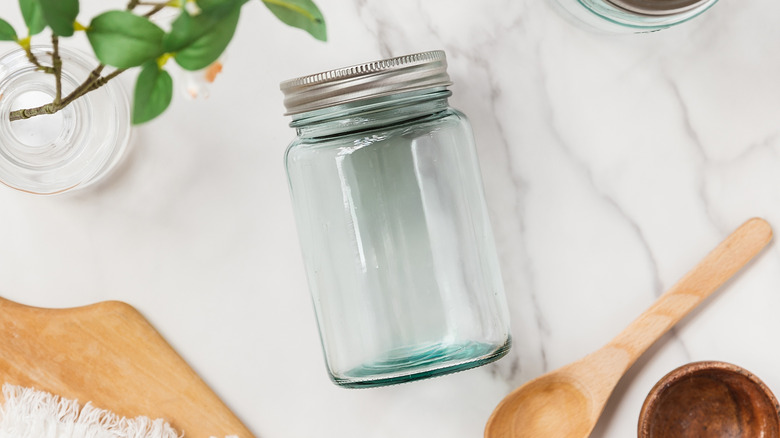Why You Should Be Storing Leftover Wine In A Mason Jar
The aromas and flavors of wine are notoriously complex — your Pinot Noir may taste of cherries and raspberries, your Sauvignon Blanc may smell of freshly cut grass and citrus, and your Zinfandel may remind you of jam and spices. But if you've ever left an open bottle out just a little too long, you'll know that spoiled wine tends to abandon all of those pleasant dimensions in favor of an overwhelmingly bitter taste and vinegary scent. And unfortunately, "a little too long" has a remarkably brief definition in the world of wine. Depending on the variety, an open bottle can last as little as a day before it begins to lose its proper flavor and texture. If you (and maybe a friend or two) don't drain the bottle in one sitting, it may go entirely to waste before you have time to finish — unless, that is, you have a Mason jar on hand.
That's right — Mason jars aren't just for homemade pickles, perfectly layered salads, and trendy restaurants in 2015. It may not match a wine bottle in aesthetic elegance, but the humble Mason jar can help preserve your open wine's flavor and aroma for longer by limiting its exposure to oxygen. You'll just fill the jar as much as you can with wine, restricting how much air is trapped inside, and seal it shut with the airtight lid. In this new container, the wine can stay fresh for five days or more.
Keep the oxygen out of your wine (mostly)
Sure, it may still sound preferable to avoid digging around in your cabinets for a Mason jar, especially when you have the wine's own bottle and cork so readily available. Well, that cork may function just fine for preservation when it's properly inserted during production, but even then, the porous material allows some oxygen to seep through — and when you reinsert the cork, you're merely sealing in air that's already entered the bottle. And oxygen is wine's natural enemy.
Okay, that's reductive of the wine-oxygen relationship. They're more like frenemies. When wine doesn't get enough oxygen during production or even once the bottle is opened and you're ready to drink, it can taste flat and even sulfuric. These flavors and aromas can often be corrected by letting the bottle breathe and allowing the wine to aerate. When oxygen and wine meet, a series of chemical reactions are triggered and begin converting ethanol to acetaldehyde, causing the wine's taste and smell to change. Initially, this will mean that certain flavors and aromas gain complexity — but when oxygen exposure and its chemical reactions last too long, wine becomes oxidized and takes on unpleasant tastes and smells.
If you fill it up, seal it tight, and place it in the refrigerator, the Mason jar will better protect your wine. Of course, it will still spoil, but storing your wine the right way will slow the chemical reactions and keep the wine fresh for longer.

